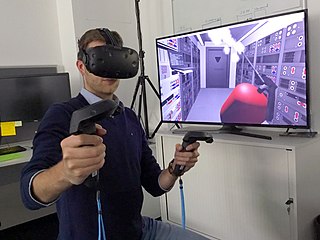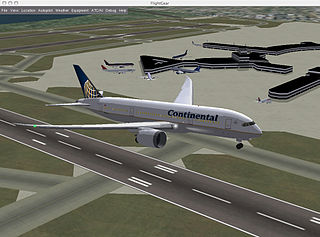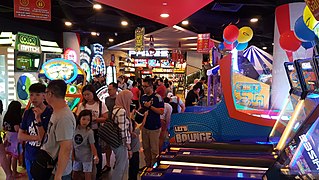The Sega VR is a unreleased virtual reality headset developed by Sega in the early 1990s. Planned as a add-on peripheral for the Sega Genesis and only publicly showcased at a number of trade shows and expositions, its release was postponed and later cancelled outright after Sega ran into development issues. At least four in-progress games for the hardware were in development before its cancellation.

Virtual reality (VR) is a simulated experience that can be similar to or completely different from the real world. Applications of virtual reality include entertainment, education and business. Other distinct types of VR-style technology include augmented reality and mixed reality, sometimes referred to as extended reality or XR.

A simulation is the imitation of the operation of a real-world process or system over time. Simulations require the use of models; the model represents the key characteristics or behaviors of the selected system or process, whereas the simulation represents the evolution of the model over time. Often, computers are used to execute the simulation.

A game controller, gaming controller, or simply controller, is an input device used with video games or entertainment systems to provide input to a video game, typically to control an object or character in the game. Before the seventh generation of video game consoles, plugging in a controller into one of a console's controller ports were the primary means of using a game controller, although since then they have been replaced by wireless controllers, which do not require controller ports on the console but are battery-powered. USB game controllers could also be connected to a computer with a USB port. Input devices that have been classified as game controllers include keyboards, mouses, gamepads, joysticks, etc. Special purpose devices, such as steering wheels for driving games and light guns for shooting games, are also game controllers.

A train simulator is a computer based simulation of rail transport operations. They are generally large complicated software packages modeling a 3D virtual reality world implemented both as commercial trainers, and consumer computer game software with 'play modes' which lets the user interact by stepping inside the virtual world. Because of the near view modeling, often at speed, train simulator software is generally far more complicated and difficult software to write and implement than flight simulator programs.
Combat flight simulators are vehicle simulation games, amateur flight simulation computer programs used to simulate military aircraft and their operations. These are distinct from dedicated flight simulators used for professional pilot and military flight training which consist of realistic physical recreations of the actual aircraft cockpit, often with a full-motion platform.

Joypolis is a chain of indoor amusement parks created by Sega and ran by CA Sega Joypolis. Beginning on July 20, 1994 with the original location sited in Yokohama, Japan, Joypolis centers have since opened in several cities in Japan and later China. The parks feature arcade games and amusement rides based on Sega's intellectual properties, original themes, and licensed franchises. Alongside the predecessor Galbo venues and the overseas spin-offs SegaWorld London and Sega World Sydney, they were officially referred to under the "Amusement Theme Park" or "ATP" concept by Sega in the 1990s.

Six degrees of freedom (6DOF) refers to the freedom of movement of a rigid body in three-dimensional space. Specifically, the body is free to change position as forward/backward (surge), up/down (heave), left/right (sway) translation in three perpendicular axes, combined with changes in orientation through rotation about three perpendicular axes, often termed yaw, pitch, and roll. Three degrees of freedom (3DOF), a term often used in the context of virtual reality, refers to tracking of rotational motion only: pitch, yaw, and roll.
Fulldome refers to immersive dome-based video display environments. The dome, horizontal or tilted, is filled with real-time (interactive) or pre-rendered (linear) computer animations, live capture images, or composited environments.

Immersion into virtual reality (VR) is a perception of being physically present in a non-physical world. The perception is created by surrounding the user of the VR system in images, sound or other stimuli that provide an engrossing total environment.

Virtuality is a line of virtual reality gaming machines produced by Virtuality Group, and found in video arcades in the early 1990s. The machines deliver real time gaming via a stereoscopic visor, joysticks, and networked units for multi-player gaming.

Amateur flight simulation refers to the simulation of various aspects of flight or the flight environment for purposes other than flight training or aircraft development. A significant community of simulation enthusiasts is supported by several commercial software packages, as well as commercial and homebuilt hardware. Open-source software that is used by the Aerospace industry like FlightGear, whose flight dynamics engine (JSBSim) is used in a 2015 NASA benchmark to judge new simulation code to space industry standards, is also available for amateur use. A popular type of amateur flight simulators are combat flight simulators, which simulate combat air operations from the pilot and crew's point of view. Combat flight simulation titles are more numerous than civilian flight simulators due to variety of subject matter available and market demand.
VRPN is a device-independent, network-based interface for accessing virtual reality peripherals in VR applications. It was originally designed and implemented by Russell M. Taylor II at the Department of Computer Science of the University of North Carolina at Chapel Hill. VRPN was maintained and supported by Sensics while it was business. It is currently maintained by ReliaSolve and developed in collaboration with a productive community of contributors. It is described more fully at vrpn.org and in VRPN-VRST.

A virtual reality headset is a head-mounted device that provides virtual reality for the wearer. Virtual reality (VR) headsets are widely used with video games but they are also used in other applications, including simulators and trainers. They comprise a stereoscopic head-mounted display, stereo sound, and head-motion-tracking sensors, which may include devices such as gyroscopes, accelerometers, magnetometers or structured light systems.

Job Simulator: The 2050 Archives is a virtual reality simulation video game developed and published by Owlchemy Labs for Microsoft Windows, PlayStation 4, Oculus Quest, and Oculus Quest 2. in which players participate in comical approximations of real-world jobs. A sequel, Vacation Simulator, was released in 2019.

A full motion racing simulator, sometimes called a full motion sim rig, is a motion simulator that is purposed for racing, and must provide motion simulation in all six degrees of freedom, as defined by the aviation simulator industry many decades ago. The six degrees of freedom coincide with Earth physics, and are commonly referred to as:

A virtual reality game or VR game is a video game played on virtual reality (VR) hardware. Most VR games are based on player immersion, typically through head-mounted display unit or headset and one or more controllers. The headset typically provides two stereoscopic displays in front of the user's eyes to simulate a 3D space.

Out-of-Home Entertainment is a term coined by the amusement industry to collectively refer to experiences at regional attractions like theme parks and waterparks with their thrill rides and slides, and smaller community-based entertainment venues such as family entertainment and cultural venues.
VR-1 is a virtual reality amusement park attraction released by Sega. Installed publicly for the first time in July 1994 at the opening of the original Joypolis indoor theme park, Yokohama Joypolis, it represented the culmination of Sega's Japanese AM teams and the Virtuality Group's collaborative developments in the field of VR. In 1996 and 1997, respectively, it was also installed at SegaWorld London and Sega World Sydney.
Cinematic virtual reality(Cine-VR) is an immersive experience where the audience can look around in 360 degrees while hearing spatialized audio specifically designed to reinforce the belief that the audience is actually in the virtual environment rather than watching it on a two-dimensional screen. Cine-VR is different from traditional Virtual Reality which uses computer generated worlds and characters more akin to interactive gaming engines, while cine-VR uses live images captured thorough a camera which makes it more like film.













